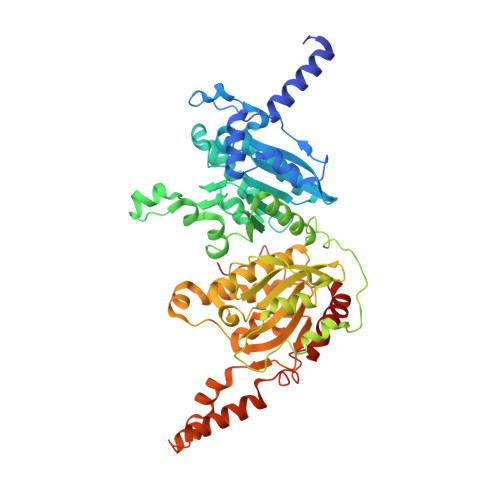Crystal Structure of the beta-Subunit of Acyl-CoA Carboxylase: Structure-Based Engineering of Substrate Specificity
Diacovich, L., Mitchell, D.L., Pham, H., Gago, G., Melgar, M.M., Khosla, C., Gramajo, H., Tsai, S.-C.(2004) Biochemistry 43: 14027-14036
- PubMed: 15518551
- DOI: https://doi.org/10.1021/bi049065v
- Primary Citation of Related Structures:
1XNV, 1XNW, 1XNY, 1XO6 - PubMed Abstract:
Acetyl-CoA carboxylase (ACC) and propionyl-CoA carboxylase (PCC) catalyze the carboxylation of acetyl- and propionyl-CoA to generate malonyl- and methylmalonyl-CoA, respectively. Understanding the substrate specificity of ACC and PCC will (1) help in the development of novel structure-based inhibitors that are potential therapeutics against obesity, cancer, and infectious disease and (2) facilitate bioengineering to provide novel extender units for polyketide biosynthesis. ACC and PCC in Streptomyces coelicolor are multisubunit complexes. The core catalytic beta-subunits, PccB and AccB, are 360 kDa homohexamers, catalyzing the transcarboxylation between biotin and acyl-CoAs. Apo and substrate-bound crystal structures of PccB hexamers were determined to 2.0-2.8 A. The hexamer assembly forms a ring-shaped complex. The hydrophobic, highly conserved biotin-binding pocket was identified for the first time. Biotin and propionyl-CoA bind perpendicular to each other in the active site, where two oxyanion holes were identified. N1 of biotin is proposed to be the active site base. Structure-based mutagenesis at a single residue of PccB and AccB allowed interconversion of the substrate specificity of ACC and PCC. The di-domain, dimeric interaction is crucial for enzyme catalysis, stability, and substrate specificity; these features are also highly conserved among biotin-dependent carboxyltransferases. Our findings enable bioengineering of the acyl-CoA carboxylase (ACCase) substrate specificity to provide novel extender units for the combinatorial biosynthesis of polyketides.
- Departamento de Microbiología, Facultad de Ciencias Bioquímicas y Farmacéuticas, Universidad Nacional de Rosario, Suipacha 531, 2000 Rosario, Argentina.
Organizational Affiliation:
















